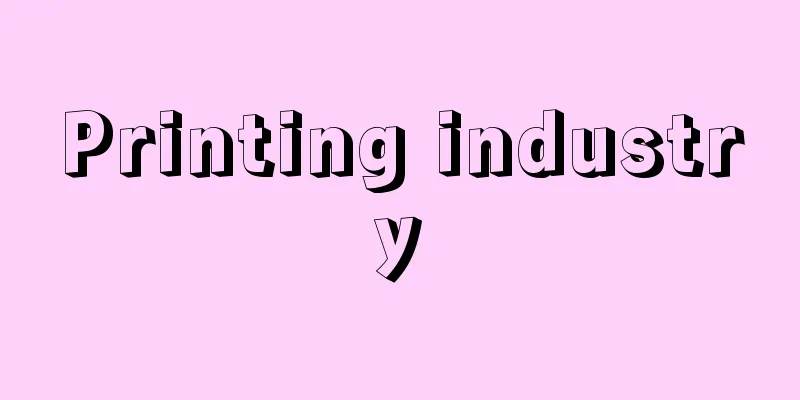Printing industry

|
An industry that uses printing techniques such as offset/lithographic, letterpress/letterpress, intaglio/gravure, screen printing (special printing such as silk screen printing), and even digital printing machines. Printing has a long history, with woodblock printing being used in China in the 8th century. Later, in the mid-15th century, the German Gutenberg invented letterpress printing, which is the basis of modern printing technology. Intaglio printing also emerged around the same time as copperplate printing. In 1798, the German Senefelder invented lithography. The printing industry in Japan began to take root in earnest in 1871 (Meiji 4) with the printing of four types of postage stamps by government ordinance. Since then, the successive increases in newspaper circulation, including the launch of the Tokyo Nichi Nichi Shimbun in 1872, and the Yomiuri Shimbun and Asano Shimbun in 1874, brought rapid market expansion to the printing industry. Printing of magazines, books, and other publications increased in addition to newspapers. In response to this situation, new printing technologies were introduced from Europe and America, expanding the industrial base of the printing industry. Around 1900 (Meiji 33), printing and publishing companies were established one after another. Of today's two major printing companies, Dai Nippon Printing was established in 1876 as Shueisha, and Toppan Printing was established in 1900 as Toppan Printing Limited Partnership Company. Kyodo Printing, which would become the third largest in terms of sales, was established in 1896 as Hakushinsha Factory. Since the period of high economic growth, the printing industry has achieved sustained growth. In particular, the increase in shipment value from offset and lithographic printing, and letterpress and letterpress printing was remarkable. In the 1970s, about 70,000 offset and lithographic printing machines and letterpress and letterpress printing machines were produced or imported, of which nearly 70% were offset and lithographic printing machines. Printing machines have continued to develop from offset sheet-fed presses, which are lithographic printing machines that print one sheet at a time, to offset web presses, which have a capacity more than 10 times that of offset sheet-fed presses and print continuously on a roll of paper. Offset web presses handle large runs, while sheet-fed presses handle relatively small runs. Since then, in terms of value, the production value of sheet-fed presses is higher, but offset web presses have also become capable of processing small lots. In the 1980s, the printing industry also saw the development of electronics in both the printing process and the printed matter. Computers and laser beams were used for color processing, layout, image composition, photo-engraving, etc., and modern plate-making systems, such as color scanners that digitally encode characters and images and rapidly reprocess the stored information, were expanding. In addition, total systemization progressed, with the shift from phototypesetters to PCs (personal computers) and DTP (desktop electronic editing systems), and transmission using ICT (information and communication technology), leading to the rise of industrial digital printing machines. As these technologies accumulated, the printing industry's key business areas included the production of shadow masks for color televisions, photomasks for integrated circuits such as ICs and LSIs, and color filters for liquid crystal displays. Large companies in particular focused on the production of electronic parts, as well as books and commercial printing. However, with the collapse of the bubble economy in the 1990s, the printing industry's performance declined, and many small and medium-sized enterprises went bankrupt due to failures in real estate investments. Although there were signs of recovery in 1993, the industry continued to stagnate in the face of the Asian currency crisis in 1997 and the collapse of the American IT bubble after 2000, and the number of establishments and nearly 20,000 employees decreased from the latter half of the 1990s to the 21st century. In the printing industry, establishments with 4 to 9 employees or less, which account for a small proportion of the industry's total manufactured goods shipment value, account for the majority of the total, and a subcontracting structure has been formed. Originally, the printing industry was centered on made-to-order production, and was centered on made-to-order production and contract production based on quality and design that matched the customer's requests and sensibilities. When it comes to the production of printed matter, there are many design revisions and interruptions, and work is sometimes outsourced, so the process is often complicated. Therefore, the unique characteristics of the printing industry, such as small order lot sizes, strict delivery deadlines, and difficult schedule management, have allowed small and medium-sized enterprises to survive. However, the serious recession has led to the bankruptcy of many uncompetitive small and medium-sized enterprises, leading to industry reorganization. The industrial structure, which is made up of a few outstanding companies and a large number of small and medium-sized enterprises that also act as subcontractors, has partially changed. While many companies have gone bankrupt, the two leading companies, Dai Nippon Printing and Toppan Printing, have expanded their efficient lithographic printing and entered the field of electronic products such as IC cards, forming an advantageous structure in their main business fields. In particular, Toppan Printing has promoted the integration of book publishing (2007). Even in the 21st century, the printing industry continues to decline, with small and medium-sized enterprises being particularly affected by economic fluctuations. In 2010, there were 10,926 printing establishments, 247,047 employees, and shipments of 5,405,278 million yen (figures for establishments with 4 or more employees from the 2010 Industrial Statistics Table). Compared to 2005, however, the number of establishments had decreased by about 2,900, the number of employees by about 29,000, and shipments by about 700 billion yen. In the wake of the Lehman Shock and the global recession, there have been many cases of businesses finding it difficult to manage their finances due to sluggish orders from major clients and a sharp drop in sales. In the printing industry, the performance of production equipment is becoming homogenized, commoditized (generalized products), and matured, making it difficult to differentiate production. This has resulted in sluggish sales of publications, a decline in bookstores' ability to attract customers, and a decrease in the amount of orders placed with printing companies. In addition to the slump in unit prices, paper prices are rising and interest burdens on capital equipment are overlapping. These factors have led to a high incidence of recession-type bankruptcies, with 80% of bankruptcies being due to sluggish sales and difficulty in collecting accounts receivable. In these cases, most small and medium-sized printing companies that have gone bankrupt have chosen to go into liquidation rather than undergoing reconstruction procedures. Furthermore, printing companies struggling with a decrease in orders are also facing the emergence of e-books. ICT-related companies have begun to publish e-books by directly contracting with authors, disrupting the process that goes through traditional printing companies, distributors, bookstores, etc. In addition to the emergence of e-books, the development and use of 3D-compatible digital printing machines and 3D printers is linked to the development of new business fields, and is likely to have a wide-ranging and serious impact on printing machines, the printing industry, and the publishing industry. In the printing industry, with the progress of the ICT revolution, it is becoming an unavoidable challenge to reexamine the significance of the industry, which has supported the transmission of information up until now, and to rebuild the foundation of its existence. While facing the fundamental problems head-on, the industry needs to address the use of ICT and digital printing, and also seek ways to contribute to the ICT revolution, promote the efficiency of complex process management, and promote the service-oriented business. [Katsuaki Onishi] "Company Chronology by Industry, Volume 7: Publishing and Printing Industry" (2000), edited and published by the Yumani Shobo Editorial Department" ▽ "The Latest Common Knowledge in Printing, by Ozaki Koji and Negishi Kazuhiro (2001, Nihon Jitsugyo Publishing)" ▽ "Complete Study of the Printing Industry, edited by the Printing Industry Research Group (2008, Sangakusha)" ▽ "Modern Japan's Publishing and Printing Industry, 2 volumes (2010, Yumani Shobo)" ▽ "Japan Printing Yearbook, various annual editions, edited and published by Japan Printing Newspaper" ▽ "The Printing and Platemaking Industry, by Sugita Hisao (Kyouikusha Shinsho)" [Reference items] | | |Source: Shogakukan Encyclopedia Nipponica About Encyclopedia Nipponica Information | Legend |
|
オフセット・平版(へいはん)、凸版・活版、凹版・グラビア、孔版(シルクスクリーン等特殊印刷)、さらにデジタル印刷機といった技術を活用して印刷を行う産業。 印刷の歴史は古く、8世紀、中国で木版による印刷が行われていた。その後15世紀中葉には、現在の印刷技術の基礎となる凸版印刷技術をドイツのグーテンベルクが発明している。凹版印刷も同時期に銅版印刷として出現した。また1798年にはドイツのゼーネフェルダーが石版印刷を発明している。 日本における印刷業の本格的定着は、1871年(明治4)の政府令による4種類の郵便切手の印刷によって始まった。それ以降、1872年の『東京日日新聞』の創刊、1874年の『読売新聞』『朝野新聞』の創刊に続く一連の新聞発行部数の増大は、印刷業に急速な市場拡大をもたらした。新聞にとどまらず、雑誌、単行本、それ以外の出版物の印刷も増加した。こうした事態に対応し、ヨーロッパ、アメリカから新しい印刷技術の導入が進められ、印刷業における産業基盤が拡充している。1900年(明治33)前後には印刷会社、出版会社の設立が相次いだ。今日の印刷大手2社の内、大日本印刷は1876年に秀英舎として、凸版印刷は1900年に凸版印刷合資会社として設立されている。売上高等で3番手となっていく共同印刷は、1896年に博進社工場として誕生している。 高度経済成長期以降、印刷業は、持続的な成長を遂げてきた。とくに、オフセット・平版印刷、活版・凸版印刷による出荷額の増大が著しかった。1970年代には、約7万台のオフセット・平版印刷機と凸版・活版印刷機が生産ないし輸入されていたが、そのうち7割近くがオフセット・平版印刷機であった。なおも、印刷機は、用紙に1枚ずつ刷っていく平版印刷機であるオフセット枚葉機から、その10倍以上の能力を有する巻取紙に連続して印刷していくオフセット輪転機へと発達している。そして、オフセット輪転機で大部数を、比較的少部数には枚葉機が対応している。その後、金額的には、枚葉機の生産額のほうが高いが、オフセット輪転機での小ロット処理も可能になった。 1980年代には印刷業においても、エレクトロニクス化が印刷工程と印刷物の両面で進展している。色調の処理、レイアウト、画像の合成、写真製版などにコンピュータやレーザー光線が活用され、文字、画像等をデジタル記号化、メモリー化した情報を高速再処理していくカラースキャナーをはじめとする近代的な製版システムが拡充している。また写真植字からPC(パーソナルコンピュータ)、DTP(机上型電子編集システム)への転換、ICT(Information and Communication Technology=情報通信技術)を活用しての伝送など、トータルシステム化が進み、産業用デジタル印刷機が台頭している。こうした技術の蓄積に随伴して、印刷業はカラーテレビ用のシャドーマスクやIC、LSIなど集積回路用のフォトマスク、液晶カラーフィルター生産などを重要な事業分野とし、とりわけ大企業は書籍、商業印刷のみでなく電子機器部品生産を主軸事業としている。 ただ、1990年代にはバブル経済の崩壊とともに、印刷業の業績は落ち込み、不動産投資の失敗にも影響され、多くの中小零細企業が倒産している。1993年(平成5)には回復する兆しをみせていたが、1997年のアジア通貨危機、2000年以降のアメリカのITバブルの崩壊等に直面して低迷を続け、1990年後半から21世紀にかけて約500事業所と2万人近くの従業者が減少している。印刷業においては、業界全体の製造品出荷額に占めるウェイトの少ない4人から9人以下の従業者を抱える事業所が全体の過半を占め、下請構造が形成されている。元来、印刷業は、オーダーメイドの受注生産を主体にしており、顧客の要望や感性に合致する品質やデザインに起点を置く受注生産、請負生産を主体としてきた。印刷物の生産に関しては、デザインの修正、割り込み作業が多く、また、作業を外注に回すこともあり、工程が錯綜(さくそう)することが少なくない。それゆえ、小規模な受注のロット・サイズ(まとまった数量の規模)、厳格な納期、困難なスケジュール管理等印刷業の特殊性が、中小零細企業を存続させてきた。だが、深刻な不況は、多数の競争力をもたない中小零細企業の倒産を招き、産業再編成を導くことになる。一部の突出した数社と多数の下請的役割をも果たす中小零細企業により構成される産業構造が、一部変容している。多くの企業が倒産する一方で、大日本印刷、凸版印刷の二大トップ企業等は、効率的な平版印刷を拡充し、ICカード等のエレクトロニクス製品関連分野にも進出して、主要事業分野において優位な体制を形成している。とくに、凸版印刷は、図書出版の統合化(2007)を進めてきた。 21世紀に突入しても、印刷業の衰退化傾向は持続しており、とくに、中小零細企業が、景気変動から受ける影響は大きかった。2010年(平成22)の印刷業の事業所数は1万0926、従業者数は24万7047人、出荷額は5兆4052億7800万円(2010年『工業統計表』従業者4人以上の事業所の数値)であったが、2005年と比べ、事業所数で約2900、従業者数で約2万9000人、出荷額で約7000億円の減少となっている。リーマン・ショック以降、世界不況のなかで主要取引先からの受注低迷、売上高の激減により、資金繰りが立ち行かなくなったケースが多くなっている。印刷業では、生産設備の性能が均質化し、コモディティ化(汎用品化)、成熟化傾向が強く、生産の差別化が困難となっており、そこに、出版物の販売不振、書店の集客力低下、印刷業者への発注量の減少が起きている。なおも、受注単価の低迷に加えて用紙価格の上昇や設備資金の金利負担が重複している。こうしたことが、販売不振、売掛金回収困難等が8割を占めるような不況型倒産の多発を招いている。その際、倒産に至った大部分の中小零細印刷業は、再建型の手続きをとるのではなく、清算型を選択している。さらに、受注減に悩む印刷業者は、電子書籍の出現にも直面している。ICT関連企業が、著者と直接契約して電子書籍を出版し始め、伝統的な印刷会社、取次、書店等を経由するプロセスを動揺させている。電子書籍等の出現のほか、3D対応のデジタル印刷機、3Dプリンターの開発と活用等は新しい事業分野の開拓に連動しており、印刷機械、印刷業、出版産業に広範で深刻な影響を与えそうである。 印刷業では、ICT革命の進展下で、これまで情報伝達を支えてきた自らの意義を再検討し、存立基盤を再構築することが、避けられない課題となっている。根本的な問題を直視しながら、ICTの活用やデジタル印刷に対処し、また、自らがICT化に貢献していく方途を模索し、複雑な工程管理の効率化や事業のサービス化を推進していく必要がある。 [大西勝明] 『ゆまに書房編集部編・刊『産業別「会社年表」総覧 第7巻 出版・印刷業』(2000)』▽『尾崎公治・根岸和広著『印刷の最新常識』(2001・日本実業出版社)』▽『印刷業界研究会編『印刷業界大研究』(2008・産学社)』▽『『近代日本の出版印刷業』全2巻(2010・ゆまに書房)』▽『日本印刷新聞社編・刊『日本印刷年鑑』各年版』▽『杉田寿夫著『印刷・製版業界』(教育社新書)』 [参照項目] | | |出典 小学館 日本大百科全書(ニッポニカ)日本大百科全書(ニッポニカ)について 情報 | 凡例 |
<<: Printing Bureau - Insatsukiyoku
Recommend
prospective study
…(2) Cohort study: A cohort is a group of people,...
Interwoven - Kousho
It is an abbreviation for weaving using one or mo...
Shiraoka [town] - Shiraoka
A former town in Minami Saitama County, eastern Sa...
Aperture Card - Aperture Card
...Because information can be handled in units of...
Amber (Belgium) - Amber
…A large trading port and coastal industrial city...
Flaiani, G.
...A disease characterized by goiter, exophthalmo...
Zen
A transliteration of the Sanskrit word dhyāna. It...
Phonology
The branch of phonology that analyzes sounds or p...
aplanogame
…The similarity of gametes is one of the reasons ...
Cestrum nocturnum
…[Ichiro Sakanashi]. … *Some of the terminology t...
Open circuit scuba diving - Kaiho Kairoshiki Scuba
...the name is an acronym for self-contained unde...
Alawites - Alawites
The secret doctrine, which originated in Shiite se...
Prahasana
...The subject matter of the Prakarana is at the ...
Okuma Finance
The financial policies promoted by Okuma Shigenob...
Mossy forest
…the leaves are smaller than those in the tropics...









